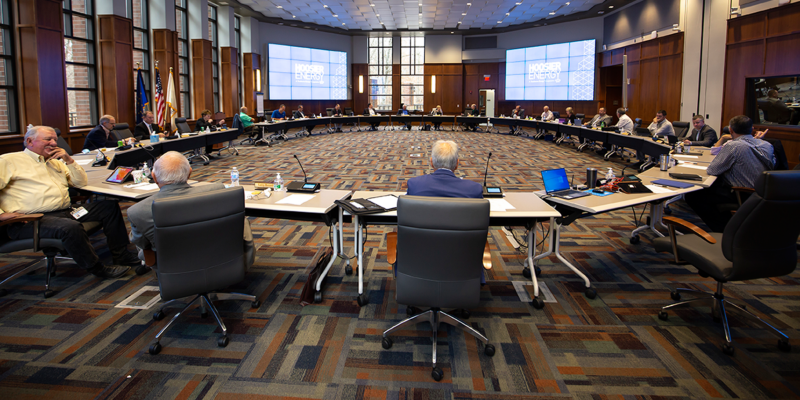
Hoosier Energy, the Bloomington, Indiana-based generation and transmission (G&T) cooperative is taking steps to leverage its data analytics and stakeholder outreach to mitigate its business risks and take advantage of identified opportunities.
Hoosier, which provides electric power and services to 18 distribution cooperative members across central and southern Indiana and southeastern Illinois, created a new position last August to build a deeper understanding of financial markets, competitive landscapes and other issues influencing the evolving energy industry. The post is also tasked with leading its environmental, social and governance (ESG) efforts—one of the first moves by a G&T to hire an ESG manager.
Jennifer Richardson, former executive director of the Indiana Office of Energy Development and chief energy adviser to Governor Eric Holcomb, has been hired for the Hoosier role. She previously represented the state before national, regional and local stakeholder and policymaking bodies to drive Indiana’s energy strategy.
“Hoosier Energy values a creative, solution-oriented approach to problem solving that embraces change, while still holding true to its mission to serve its member systems,” Hoosier Energy President and CEO Donna Walker said. “With her extensive energy policy experience and proven analytical, planning and advising skills, Jennifer is the perfect fit for Hoosier Energy and our vision moving forward.”
Strategic intelligence is an important part of achieving that vision. Put simply, strategic intelligence involves the collection, processing and analysis of data that are required to formulate policy. And in today’s dynamic world, there is an ever-increasing amount of data to collect and analyze in order to make informed policy decisions.
Richardson's Role Will Help Maintain Hoosier's Strengths, Identify New Opportunities
“While Hoosier Energy is grounded in its foundational principles as a cooperative, it continuously looks to improve how we do what we do,” Richardson explained. “This includes hiring practices, fostering a culture of operational excellence, prudent financial management and technology innovation, to name a few areas. My role is charged with helping maintain our strengths while also identifying and evaluating new opportunities to enhance aspects of the business where it makes the most sense.”
Hoosier has created a focused effort to evaluate its approach to the scope of issues facing the energy industry—from rate design, to portfolio transition, to new technology. The goal is to position the G&T to most effectively deal with any challenges and opportunities, with a strong focus on reliability, affordability and flexible solutions for its members.
“Essentially, Hoosier Energy has taken a sledgehammer to traditional departmental silos by creating a 360-degree look at itself and acknowledging we need input from our brightest staff—and key stakeholder groups—in order to effectively solve problems, mitigate risks and drive value for members and the communities they serve, as well as our employees,” Richardson said.
ESG is an increasingly important area of focus and analysis.
ESG Is a Risk-Mitigation Tool at Hoosier
“At Hoosier, we believe ESG is one of our risk-mitigation tools, as well as a key input to value creation for the organization,” Richardson said. “And we have been able to take proactive steps to incorporate ESG into our business practices and decision-making.”
For example, the G&T launched an ESG pilot program at the end of 2020 to help identify an optimal ESG reporting and disclosure framework. A key component of the pilot was a materiality assessment that included broad outreach to the G&T’s stakeholders.
“Stakeholder engagement is a critical component of our ESG initiatives because we want to create a process that is valid, meaningful and can be replicated,” Richardson said. “We want to ensure our activities are not based solely on our own perspectives, but instead reflect the priorities of those we serve. This will help us to mitigate risk, capture a holistic picture of operations and demonstrate the value that we provide to our members.”
Data analysis from the pilot yielded 16 overarching ESG issues that were most important and relevant to its stakeholders. These issues now closely align with the G&T’s own risk-management categories.
“With ESG, we have been given the opportunity to formalize our processes to align various interdepartmental efforts in order to create a recognized framework and reporting mechanism for the benefit of the organization, as well as our member systems, if they so choose,” Richardson explained.
Stakeholders Are Placing Greater Importance on ESG-Related Risks
As investors and rating agencies place a greater emphasis on ESG-related risks, Hoosier’s work to date on formalizing its ESG processes and priorities has been well received by the financial community.
“In our most recent meetings with ratings agencies, there was a robust ESG discussion,” Richardson said. “Hoosier Energy included the structure of our pilot, data collection efforts and how we will be communicating and disclosing our results going forward. I am pleased to report that we have received very positive feedback on our decision to formalize this journey.”
The overarching ESG process is dynamic, iterative and provides a unique opportunity to refine the G&T’s priorities over time to ensure they remain aligned with its core principles.
“The process is also forward-looking for the benefit of both us and our members,” Richardson said. “For those who are interested, we would be pleased to share our experience so other cooperatives can benefit from our journey.”
